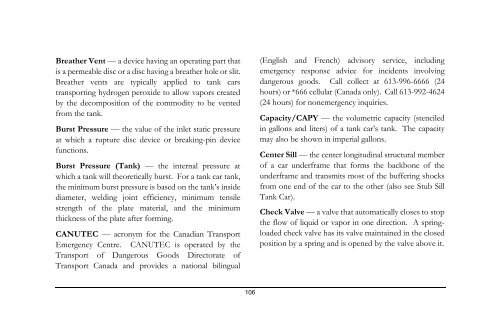Third Edition
2017%20Field%20Guide%20for%20Tank%20Cars
2017%20Field%20Guide%20for%20Tank%20Cars
You also want an ePaper? Increase the reach of your titles
YUMPU automatically turns print PDFs into web optimized ePapers that Google loves.
Breather Vent — a device having an operating part that<br />
is a permeable disc or a disc having a breather hole or slit.<br />
Breather vents are typically applied to tank cars<br />
transporting hydrogen peroxide to allow vapors created<br />
by the decomposition of the commodity to be vented<br />
from the tank.<br />
Burst Pressure — the value of the inlet static pressure<br />
at which a rupture disc device or breaking-pin device<br />
functions.<br />
Burst Pressure (Tank) — the internal pressure at<br />
which a tank will theoretically burst. For a tank car tank,<br />
the minimum burst pressure is based on the tank’s inside<br />
diameter, welding joint efficiency, minimum tensile<br />
strength of the plate material, and the minimum<br />
thickness of the plate after forming.<br />
CANUTEC — acronym for the Canadian Transport<br />
Emergency Centre. CANUTEC is operated by the<br />
Transport of Dangerous Goods Directorate of<br />
Transport Canada and provides a national bilingual<br />
(English and French) advisory service, including<br />
emergency response advice for incidents involving<br />
dangerous goods. Call collect at 613-996-6666 (24<br />
hours) or *666 cellular (Canada only). Call 613-992-4624<br />
(24 hours) for nonemergency inquiries.<br />
Capacity/CAPY — the volumetric capacity (stenciled<br />
in gallons and liters) of a tank car’s tank. The capacity<br />
may also be shown in imperial gallons.<br />
Center Sill — the center longitudinal structural member<br />
of a car underframe that forms the backbone of the<br />
underframe and transmits most of the buffering shocks<br />
from one end of the car to the other (also see Stub Sill<br />
Tank Car).<br />
Check Valve — a valve that automatically closes to stop<br />
the flow of liquid or vapor in one direction. A springloaded<br />
check valve has its valve maintained in the closed<br />
position by a spring and is opened by the valve above it.<br />
106


